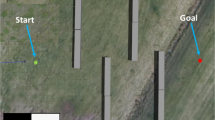Abstract
A high degree of mobility, reliability, and efficiency are needed for autonomous exploration of extreme terrain. These requirements have guided the development of the Ambler, a six-legged robot designed for planetary exploration. To address issues of efficiency and mobility, the Ambler is configured with a stacked arrangement of orthogonal legs and exhibits a unique circulating gait, where trailing legs recover directly from rear to front. The Ambler is designed to stably traverse a 30 degree slope while crossing meter sized features. The same three principles have provided many constraints on the design of a software system that autonomously navigates the Ambler through natural terrain using 3-D perception and a combined deliberative/reactive architecture. The software system has required research advances in real-time control, perception of rugged terrain, motion planning, task-level control, and system integration. This paper presents many of the factors that influenced the design of the Ambler and its software system. In particular, important assumptions regarding the mechanism, perception, planning, and control are presented and evaluated in light of experimental and theoretical research of this project.
Similar content being viewed by others
References
B. Wilcox, “Robotic vehicles for planetary exploration,” Applied Intelligence, vol. 2, no. 2, pp. 181–193, 1992.
J. Bares, “Configuration of autonomous walkers for extreme terrain,” Ph.D. thesis, Department of Civil Engineering, Carnegie Mellon University, 1991.
S. Song and K. Waldron, Machines that Walk: The Adaptive Suspension Vehicle, MIT Press, 1989.
S. Hirose, “A study of design and control of a quadruped walking vehicle,” International Journal of Robotics Research, vol. 3, no. 2, pp. 113–133, 1984.
K. Waldron and G. Kinzel, “The relationship between actuator geometry and mechanical efficiency in robots,” 4th CISM-IFToMM Symposium on Theory and Practice of Robots and Manipulators, Warsaw, Poland, 1983, pp. 305–316.
M. Raibert, Legged Robots That Balance, MIT Press, 1986.
F. Pfeiffer, H. J. Weidermann, and P. Danowski, “Dynamics of the walking stick insect,” IEEE Control Systems, vol. 11, no. 2, pp. 9–13, 1991.
R. Brooks, “A robot that walks: Emergent behavior from a carefully evolved network,” Neural Computation, vol. 1, no. 2, pp. 253–262, 1989.
D. Manko, “A general model of legged locomotion on natural terrain,” Ph.D. thesis, Department of Civil Engineering, Carnegie Mellon University, 1990.
I. S. Kweon and T. Kanade, “High resolution terrain map from multiple sensor data,” Proceedings of the IEEE International Workshop on Intelligent Robots and Systems, Tsuchiura, Japan, 1990, pp. 127–134.
I. S. Kweon, R. Hoffman, and E. Krotkov, “Experimental characterization of the Perceptron laser range-finder,” Robotics Institute Technical Report, CMU-RI-TR-91-1, Carnegie Mellon University, 1991.
H. Thomas, D. Wettergreen, C. Thorpe, and R. Hoffman, “Simulation of the Ambler environment,” Proceedings of the 23rd Pittsburgh Conference on Modeling and Simulation, 1990.
I. S. Kweon, “Modeling rugged terrain by mobile robots with multiple sensors,” Ph.D. thesis, Robotics Institute, Carnegie Mellon University, 1991.
D. Wettergreen, H. Thomas, and C. Thorpe, “Planning strategies for the Ambler walking robot,” Proceedings of the IEEE International Conference on Systems Engineering, 1990.
P. Pal and K. Jayarajan, “Generation of free gait—A graph search approach,” IEEE Transactions on Robotics and Automation, vol. 7, no. 3, pp. 299–305, 1991.
G. T. Hsu and R. Simmons, “Learning footfall evaluation for a walking robot,” Proceedings of the Machine Learning Workshop, Chicago, IL, 1991.
R. Simmons, “An architecture for coordinating planning, sensing, and action,” Proceedings of the DARPA Workshop on Planning, San Diego, CA, 1990.
R. Simmons, “Concurrent planning and execution for a walking robot,” Proceedings of the IEEE International Conference on Robotics and Automation, Sacramento, CA, 1991, pp. 300–305.
P. Nagy, “An investigation of walker/terrain interaction,” Ph.D. thesis, Department of Mechanical Engineering, Carnegie Mellon University, 1991.
R. Hoffman and E. Krotkov, “Perception of rugged terrain for a walking robot: True confessions and new directions,” Proceedings of the International Workshop on Intelligent Robots and Systems, Osaka, Japan, 1991, pp. 1505–1510.
Author information
Authors and Affiliations
Rights and permissions
About this article
Cite this article
Simmons, R., Krotkov, E., Whittaker, W. et al. Progress towards robotic exploration of extreme terrain. Appl Intell 2, 163–180 (1992). https://doi.org/10.1007/BF00058761
Issue Date:
DOI: https://doi.org/10.1007/BF00058761




